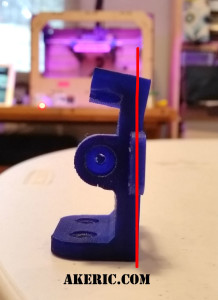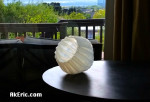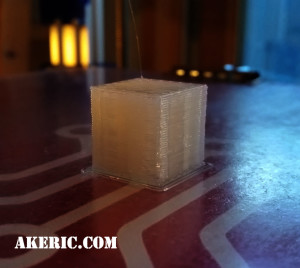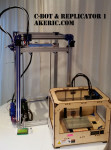Jump to C-Bot blog index to see all the posts.
I figured at some point something would go wrong: It finally did.
I’d noticed the stepper for the Bowden extruder had been running really hot. Hot to the touch, and way hotter than the other steppers. I had started by setting it’s reference voltage to .6v (like all the others), but it didn’t have enough ‘oomph’ to drive the filament through the extruder. So I increased the voltage until it started behaving, which ended up being around 1.2v (2x as much as recommended…). I’m sure this contributed to the over-heating. But I wasn’t sure what else to do: Any lower voltage wouldn’t extrude properly.
I’d been pointing a small fan at the stepper, and this seemed to keep it’s temp at a reasonable (but still hot) temp. And since things had been going so well I decided to do my first “big print”: Fired it off, and for the first 20 minutes all was well. I decided to take a walk. When I returned an hour later, to my surprise it was air-printing: I found this really surprising with a Bowden (heat-creep on my Replicator 1’s direct-drive can cause this more easily). The Bowden stepper was still turning, so I figured some how it had notched the filament. But there was no notch, it just wasn’t extruding. That’s when I noticed this:

Top view, looking ‘down’.
When I went to touch the stepper, it was burning hot: I had forgot to turn on my cooling fan, and the stepper had gotten so hot it melted the printed Bowden mechanism 
The great thing about having two printers is you’re always able to print, even if one breaks: I re-printed the melted bits and after two hours bolted them back on. But I obviously still needed to do something about the heat. I was perplexed why this one stepper needed 2x the voltage of the others. So using the techniques mentioned before, I reset the reference voltage on the DRV8825 back to .6v, and tried extruding: I worked fine. Huh?
I’ve noticed while building this bot that stuff like this often happens: I’ll set some value that doesn’t seem right, but works. A day later, I’ll reset it to the ‘correct’ value, and then it works as expected. I don’t know how to explain this, but it’s not the first time it’s happened.
But it’s printing great now: I’m an hour back into the ‘big print’, extrusion is good, stepper is ‘normal temp’.
Live and learn!
Jump to C-Bot blog index to see all the posts.








